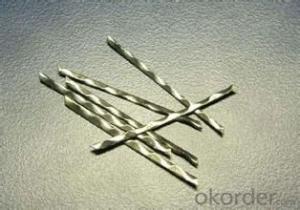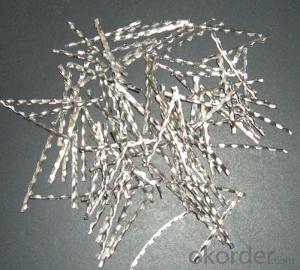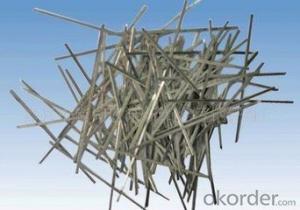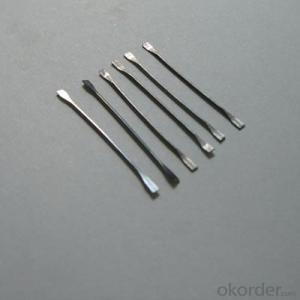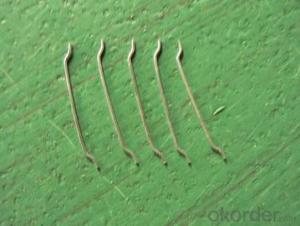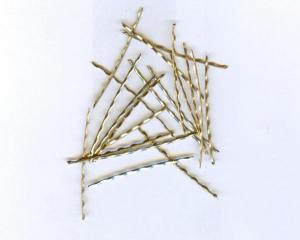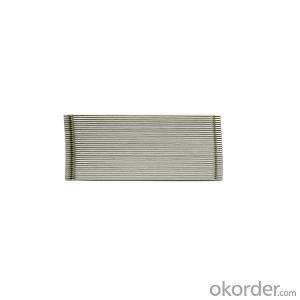Concrete Admixtures Steel Fiber Reinforced From CNBM International
- Loading Port:
- Tianjin
- Payment Terms:
- TT OR LC
- Min Order Qty:
- 1000 kg
- Supply Capability:
- 250000 kg/month
OKorder Service Pledge
OKorder Financial Service
You Might Also Like
Quick Details
Place of Origin: Shandong, China (Mainland)
Model Number: steel fiber
material: steel wire
application: concrete reinocement
type: end hook steel fiber
Product features
with excellent tensile ,hightenacity ,against cracking and fatigue ,they`re widely usd in the structures made of concrete
Specifications
1.hooked steel fiber
2.CE and ISO9001:2008
3.diameter from 0.5mm to 1.2mm
4.competitive price,high quality and service
Hooked Steel Fiber:
1.Diameter:0.5mm-1.0mm
2.Length: 25mm-60mm
3.Material: low carbon steel wire
4.Feature: excellent tensile,high tenacity,against cracking,impact and fatigue
5.Uses: high way,tunnel,building,airport road serface and so on .
Picture
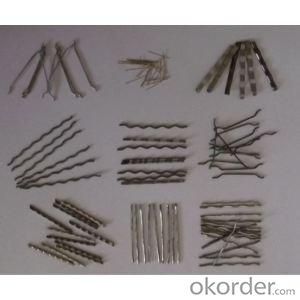
steel fiber concrete reinforced
FAQ
we can produce any type steel fiber and of course we can make production according to your requirement
we have specilize in this field for almost 10 years ,with good quality and competitive price
- Q:What is the difference between melt extract stainless steel fiber and other types of steel fibers?
- Melt extracted stainless steel fiber, also referred to as melt extract steel fiber, is produced by melting stainless steel and then swiftly drawing it into fine fibers. This manufacturing process yields fibers with distinct properties and characteristics compared to alternative steel fibers. An important distinction of melt extract stainless steel fiber from other varieties is its improved resistance to corrosion. Stainless steel is renowned for its capacity to withstand corrosion and oxidation, rendering melt extract stainless steel fibers highly impervious to rust and degradation over time. Consequently, they are suitable for use in environments prone to exposure to moisture, chemicals, or other corrosive substances. Another distinction lies in the heightened tensile strength of melt extract stainless steel fibers. The expedited extraction process aligns the steel molecules, resulting in fibers that are more robust and durable than their counterparts. This augmented tensile strength makes melt extract stainless steel fibers optimal for reinforcing concrete or other materials that necessitate high strength and durability. Additionally, melt extract stainless steel fibers exhibit exceptional thermal and electrical conductivity. This attribute makes them suitable for applications requiring efficient heat or electricity transfer. For instance, they can be employed in heating elements, electromagnetic shielding, or as conductive reinforcement in composites. Lastly, melt extract stainless steel fibers possess a smoother surface compared to other steel fibers. This smooth surface promotes improved bonding with the surrounding matrix, such as concrete or resin, leading to enhanced load transfer and overall performance. Furthermore, the smoothness reduces the likelihood of fiber pull-out or breakage, further enhancing their effectiveness as reinforcement materials. In conclusion, melt extract stainless steel fibers distinguish themselves from alternative steel fibers due to their enhanced corrosion resistance, increased tensile strength, exceptional thermal and electrical conductivity, and smoother surface. These distinctive properties render them a preferred choice for various applications requiring high-performance reinforcement materials.
- Q:Is melt extract stainless steel fiber compatible with various types of cement?
- Yes, melt extract stainless steel fiber is compatible with various types of cement.
- Q:What is the average length of melt extract stainless steel fiber?
- The average length of melt extract stainless steel fiber is typically around 50mm to 65mm.
- Q:Can melt extract stainless steel fiber be used in architectural precast cladding?
- Certainly, architectural precast cladding can make use of melt extract stainless steel fiber. Due to their exceptional strength, durability, and resistance to corrosion, stainless steel fibers are widely employed in architectural applications. These fibers can greatly enhance the tensile and flexural strength of precast cladding, minimize cracking, and bolster its resistance to impact and abrasion. Moreover, stainless steel fibers provide design flexibility and can be seamlessly integrated into the concrete mixture without compromising its workability. As a result, the incorporation of melt extract stainless steel fiber in architectural precast cladding can significantly enhance the lifespan and functionality of the cladding system.
- Q:How does melt extract stainless steel fiber impact the load transfer between concrete layers?
- Melt extract stainless steel fibers enhance load transfer between concrete layers by improving the bond strength and overall mechanical properties of the concrete. These fibers act as reinforcement, dispersing stress and preventing crack propagation, thereby increasing the load-carrying capacity and durability of the concrete structure.
- Q:Is melt extract stainless steel fiber compatible with different types of admixtures?
- Yes, melt extract stainless steel fiber is compatible with different types of admixtures.
- Q:Can melt extract stainless steel fiber be used in swimming pool structures?
- Swimming pool structures can indeed incorporate melt extract stainless steel fiber. The attributes of stainless steel fibers, such as their exceptional strength, durability, and resistance to corrosion, make them highly suitable for a diverse range of applications, including swimming pool structures. By introducing these fibers into the concrete mix utilized for constructing pool walls, floors, and other components, their overall strength and durability can be significantly enhanced. Moreover, the presence of stainless steel fibers aids in the prevention of cracking and boosts resistance to water and chemical damage, a particularly crucial factor within a swimming pool environment. Furthermore, the utilization of stainless steel fibers contributes to the elongation of the lifespan and improvement of the overall performance of the pool structure, thereby reducing the necessity for maintenance and repairs.
- Q:Does melt extract stainless steel fiber improve the resistance to efflorescence in concrete?
- Yes, melt extract stainless steel fiber can improve the resistance to efflorescence in concrete. Efflorescence occurs when water-soluble salts are carried to the surface of concrete by moisture. These salts can react with carbon dioxide and form unsightly white deposits on the surface of the concrete. By incorporating melt extract stainless steel fiber into the concrete mix, the fibers can help to reduce the formation of efflorescence. The stainless steel fibers enhance the durability and performance of concrete by providing reinforcement and reducing the formation of cracks. This, in turn, helps to minimize the ingress of moisture and prevent the migration of salts to the surface of the concrete. Furthermore, the stainless steel fibers have a high resistance to corrosion, which means they can withstand exposure to various environmental conditions, including those that promote efflorescence. This resistance to corrosion ensures that the fibers continue to provide reinforcement and prevent the deterioration of the concrete over time. Therefore, melt extract stainless steel fiber can be an effective solution for improving the resistance to efflorescence in concrete, providing long-term durability and aesthetic appeal to the structure.
- Q:Are there any specific mixing requirements for concrete with melt extract stainless steel fiber?
- Concrete with melt extract stainless steel fiber has specific mixing requirements. Achieving the desired performance and properties requires ensuring proper dispersion and distribution of the fibers. To incorporate stainless steel fiber into the concrete, it is necessary to add them during the mixing process. Using a high-performance mixer is recommended to ensure even distribution throughout the mixture. Adding the fibers slowly and continuously is important to prevent clumping and ensure thorough integration. The mixing time needs to be extended to ensure proper fiber dispersion. The recommended mixing time depends on the type and length of the stainless steel fiber and the desired concrete properties. Generally, a longer mixing time is necessary compared to conventional concrete mixes for good fiber distribution. It is crucial to avoid excessive mixing as it can cause fiber breakage and reduce effectiveness. Following the manufacturer's guidelines and recommendations regarding specific mixing requirements for the stainless steel fiber is essential. Furthermore, adjusting the concrete mix design may be necessary to accommodate the addition of stainless steel fibers. Modifying the water-cement ratio, aggregate grading, and other mix proportions can achieve the desired workability and performance. In conclusion, proper mixing is vital for concrete with melt extract stainless steel fiber to ensure uniform distribution and maximize the benefits of adding the fibers. These benefits include enhanced tensile strength, crack resistance, and durability. Consulting with the manufacturer or a qualified engineer is recommended to determine the specific mixing requirements for the stainless steel fiber used in your concrete mix.
- Q:What is the typical fiber length and diameter of melt extract stainless steel fiber?
- The specific manufacturer and application requirements can cause variations in the typical fiber length and diameter of melt extract stainless steel fiber. However, a general range for the length of these fibers is typically from a few millimeters to several centimeters. The diameter of these fibers can range from around 10 micrometers to 50 micrometers. These dimensions are carefully selected to ensure the desired properties, such as strength, durability, and thermal conductivity, for a variety of applications. These applications include reinforcement in composites, thermal insulation, and electromagnetic shielding.
1. Manufacturer Overview |
|
|---|---|
| Location | |
| Year Established | |
| Annual Output Value | |
| Main Markets | |
| Company Certifications | |
2. Manufacturer Certificates |
|
|---|---|
| a) Certification Name | |
| Range | |
| Reference | |
| Validity Period | |
3. Manufacturer Capability |
|
|---|---|
| a)Trade Capacity | |
| Nearest Port | |
| Export Percentage | |
| No.of Employees in Trade Department | |
| Language Spoken: | |
| b)Factory Information | |
| Factory Size: | |
| No. of Production Lines | |
| Contract Manufacturing | |
| Product Price Range | |
Send your message to us
Concrete Admixtures Steel Fiber Reinforced From CNBM International
- Loading Port:
- Tianjin
- Payment Terms:
- TT OR LC
- Min Order Qty:
- 1000 kg
- Supply Capability:
- 250000 kg/month
OKorder Service Pledge
OKorder Financial Service
Similar products
New products
Hot products
Related keywords
